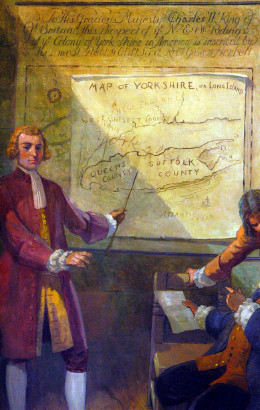World
About Andrew Cusack
 Writer, web designer, etc.; born in New York; educated in Argentina, Scotland, and South Africa; now based in London.
Writer, web designer, etc.; born in New York; educated in Argentina, Scotland, and South Africa; now based in London. read more
News
Blogs
Reviews & Periodicals
Arts & Design
World
France
Mitteleuropa
Knickerbockers
Argentina
The Levant
Africa
Cape of Good Hope
Netherlands
Scandinavia
Québec
India
Muscovy
Germany
Academica
The Governor’s Suite, City Hall
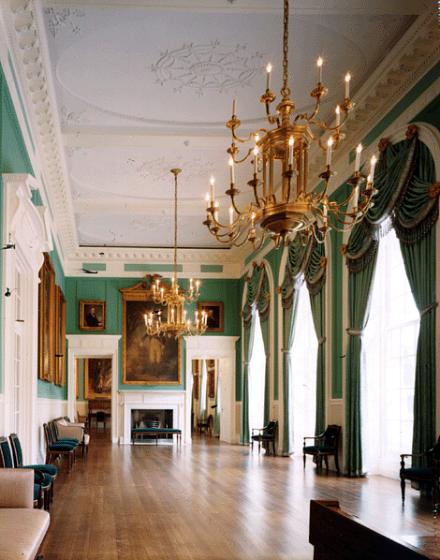
I HAVE NEVER been inside New York’s City Hall, though I have walked or driven past it on a number of occasions. With tall skyscrapers of various ilks towering over it, it always seemed rather small and inconsequential, and I knew nothing of the interiors save the Blue Room in which the Mayor usually gives press conferences and the rotunda which is fairly well-known as well.
I was delighted, therefore, to stumble upon the above photo of the recently-restored Governor’s Suite in City Hall, which shows it to have a rather handsome interior. Since the state government embarked upon an up-river journey to Albany, I presume the purpose of the Governor’s Suite is to provide a place for New York’s head of state to receive and entertain important dignitaries visiting the Big Apple. The current green color of the walls seems much preferable to the previous and rather dull white. I must endeavour to visit City Hall when I next return to the metropolis. (more…)
The Eastchester Covenant
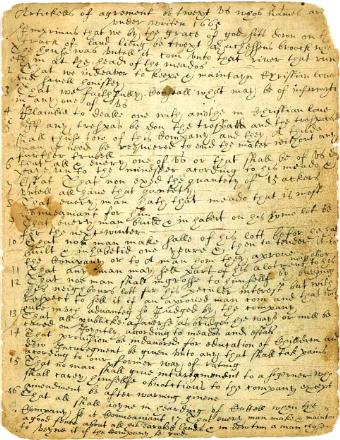
The Town of Eastchester, New York was settled in 1664 and in the following year the English inhabitants thereof drew up a covenant binding all the townsfolk. Among the various articles within this foundational tract are sensible pronouncements guaranteeing the rights of private property, forbidding trespassing, and a promise to “indeavor to keepe & maintayn Christian love and sivell honesty”.
My favorite part, however, is article 15, stating that “no man shall entertain obnoxious foreigners”.
The Knights of Malta Ball 2006

BACK DOWN TO the Assembly Rooms of Edinburgh for the annual ritual of the Knights of Malta Ball and I am happy to report that, as per usual, a good time was had by all. We had a larger contingent heading down from the Auld Grey Toon than last year (when it was just Fräulein Hesser and myself), consisting of Abigail, Jon Burke, Stefano, Clare Dempsey, and yours truly. After gliding down from Fife via taxicab, we met up with Zygmunt Sikorski-Mazur, Jamie Bogle (sans Joanna, alas), and Gerald Warner at the Opal Lounge, a little past half six, and managed to pack in at least a round of drinks before heading across George Street to the Assembly Rooms (depicted in the engraving below).

Having dropped off our coats and such, we swept up the staircase to the Ballroom for some champagne before dinner. After mulling about and conversing for a while we bumped into the Cardinal Archbishop of St Andrews himself, H.E. Keith Patrick O’Brien, himself a Grand Cross Conventual Chaplain to the Order of Malta. We apologised for not maintaining his senior cathedral in St Andrews in the same state as his junior one in Edinburgh, but I did thank him profusely for allowing us an indult mass at Ravelston. (more…)
The Two Germanies
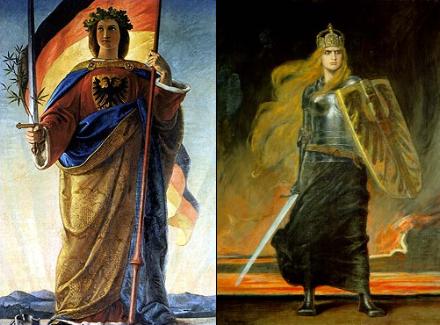
A recent post by Aelianus entitled The Two Germanies brought to mind a little-known idea which surfaced towards the end of World War II. I read in the biography of Empress Zita that a plan was hatched to divide what we now know as Germany, combining Bavaria and Austria to create a Catholic state under the restored Hapsburgs and leaving northern Germany to be a Protestant kingdom with, odd as it might perhaps seem, Lord Louis Mountbatten. Of course it’s not really that odd when one considers that the real name of the Mountbatten family is Battenberg, changed to disguise their Teutonicity during the Great War when the fervor of hatred against our cousin the Hun ran willy-nilly. While Mountbatten was born in Windosr Castle and served as First Sea Lord as well as the final Viceroy of India, he was really entirely German in terms of ancestry. His parents were Prince Louis of Battenberg and Princess Victoria of Hesse and the Rhine, while Louis IV, Grand Duke of Hesse and the Rhine was his grandfather. By right, he was His Serene Highness Prince Louis of Battenberg, but cherishing their adopted country, the family were intimidated into dropping all German styles and titles in 1917.
Lord Mountbatten apparently took the proposal seriously enough that he began to brush up on his German, and informed Empress Zita, living in exile in the Dominion of Canada during the Second World War, of its prospects for both their families. Of course, with Yalta, nothing was ever to come of it and the closest Lord Mountbatten ever came to power, aside from his reign as Viceroy of India, was in 1967 when he was alledgedly asked to lead a coup overthrowing the Labour government. Mountbatten was highly reluctant, and nothing came of the plot. In 1979, while summering at his usual holiday home in the Irish Republic, Mountbatten was killed by an IRA bomb, along with the Dowager Lady Brabourne (aged 82), the Hon. Nicholas Knatchbull (aged 14), and Paul Maxwell (aged 15), a local boy working on the Mountbatten’s boat. He was a Knight of the Garter, a Knight Grand Cross of Bath, Order of Merit, Knight Grand Cross of the Star of India, Knight Grand Cross of the Indian Empire, Knight Grand Cross of the Royal Victorian Order, and the Distinguished Service Order.
Monster Swallows Village Whole
‘But will it give birth?’ the Villagers Inquire
“NYU is the largest private university in the United States and they are growing,” Andrew Berman, executive director of the Greenwich Village Society for Historic Preservation, told Community Board 2 Thursday night. “They are growing at a much faster pace than our neighborhood is. NYU has always been here. It should always be here. I don’t think the Village would be the Village if NYU wasn’t here. But I don’t think the Village can stay the Village if it is predominantly NYU.” And so a new campaign to get NYU to check it’s own expansions in the Village by creating a “secondary campus” begins. [Gothamist]
A secondary campus such as, for example, the one they sold off in 1979? I would have to concur that NYU has grown rather too large for the Village’s britches, and the fact that NYU is trying to build a towering dormitory where St. Ann’s once stood doth not encourage feelings of merriment (though, of course, the blame for that belongs mostly to our archbishop from the Middle West). At any rate, perhaps NYU can strike a deal and buy back the University Heights campus. Unlikely, since the City University of New York which now owns the campus (run as Bronx Community College) would probably like to see itself as a competitor to NYU (it isn’t; they’re leagues apart).
Of course one idea is to stop expanding and maintain the current size and facilities of the university, but this is unlikely. NYU have displayed a Hitlerian glee in the acquisition of neighboring properties, and, to stretch the analogy beyond any rational use, Fordham, St. John’s, and Columbia have no strategic interest in acting as the UK, US, and Soviet Union (respectively) in uniting to counter that expansion.
Previously: Thoughts on NYU et cetera | Back in the Day | New Washington Square Plans | NYU – Old & New
Improvements
REACTIONARIES HAVE FOOLED themselves into believing the world has been getting worse and worse, essentially since the Fall. Progressives meanwhile, heartened by fairly recent progress-heralding genocidal masterpieces such as the French, Russian, and Chinese revolutions, believe the world is getting better and better with the March of Time. But we, the happy middle, – conservatives and traditionalists – know that Man is as Man was and as Man will be, and that we will see days of sadness and terror just as we will see days of greatness and glory. It was found to be greatly encouraging, therefore, when I chanced upon the Mess of the Officer Training Corps here in St Andrews last night and was greeted not by the bilious throbbing beats of noxious rap music, but instead by the dulcet syncopations of Tchaikovsky’s Swan Lake. Under the attentive ear of J.E.B., new President of the Mess Committee, A Squadron, TUOTC, I am happy to report that bad music has been given the old heave-ho.
YET, AS THE commendable is oft accompanied by the regretable, the hallowed pasttime of smoking has tragically been banned in the Mess. This is doubly wounding as the ban has taken place before the Scottish ban on smoking in public places takes effect (March 27), but also because the Mess is Ministry of Defence property and thus effectively exempt from the ban. Alas, the spirit of bureaucracy and nanny-ism has partly infected (some would say taken over) the caverns of the M.o.D. and decrees were handed down from above that smoking would be banned from January 1, 2006. Shameful, as it was one of the best places to enjoy a toke on the old pipe, especially since a pipe rack (donated by J.E.B. himself) was dutifully placed on the mantle below the portrait of Her Majesty. Nonetheless, we look forward to continued improvements under the tenure of Mr. J.E.B., and wish him well.
A Journey to Mells
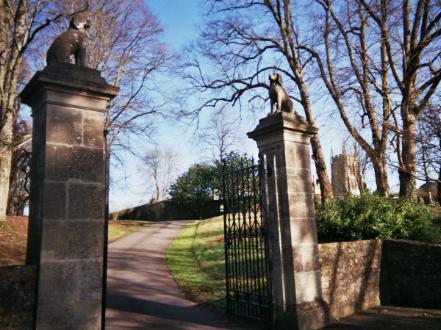
A good number of we happy St Andreans were down in the West Country recently — Somerset to be precise — for the wedding of two of our dear and closest friends [to be covered in a later post]. Being in Somerset, Alec, “Ishmael”, Clare and my good self decided to hop over to the little village of Mells last Friday to see the grave of Msgr. Ronald Knox and to sup at what is known as one of the best pubs in all of England. (more…)
Return and Remembrance
Well, yours truly has dutifully returned to hallowed Andreanopolis in pursuit of his last Candlemas term ever, to be capped off (Deo gratia) by the awarding of Master of the Arts degree this June. George Ronald Valentine Hastings Irwin picked me up from the airport on Friday morning and expressed his shock that he was graduating on time in the alloted four years and his even greater shock that I too am on course to complete the very same task.
As we drove down the Guardbridge Road towards our ancient seat of learning, the turrets, towers, and spires of the Royal Burgh were completely shrouded in haugh, that peculiar Scottish form of fog that rolls off the North Sea. Returning to dear old Sallies I came upon Dawn and Lisa, the two cleaners responsible for our corridor, chatting in the hallways (as is their wont), welcoming my return while lamenting my longer-than-ordinary absence. Most of the day was spent unpacking my various posessions. Because St. Salvator’s Hall was used to host a conference over the break, all the inhabitants thereof had been forced to pack away their belongings in storage. Thus after picking up my key from the porter and turning the lock on my room, I was greeted not by the welcome signs of my inhabitation but instead by a room bare but for the rearranged furniture, a different lamp (which doesn’t work, unlike the previous one), and the usual New International Version of the Holy Bible in the desk drawer.
Much to my lamentation, I quickly discovered that the great majority of my cohortem had skipped off to Pluscarden Abbey for a few days. Nonetheless, the trusty Alexander O’Hara was amongst the remaining and we met for a pint at the Whey Pat, just outside the town’s remaining city gate, before repairing to the Cellar Bar for a better brew. The following morning I met up with Ishmael for breakfast at the Victoria Café. [TEXT REDACTED]
After breakfast, I fell asleep in the library reading La Vita Nuova (apologies to Mr. Aligheri, but I did finish it when I awoke). After a woefully disappointing luncheon in hall, followed by ever-so-slighly less disappointing but more filling microwave meal to fill my empty belly, I watched Passport to Pimlico, the splendid Ealing Comedy in which the bombed-out inhabitants of a street in Pimlico discover an ancient document revealing that their home turf is actually an independent territory of the Duke of Burgundy. (Upon the revelation, the local Police Constable Spiller exclaims “Blimey, I’m a foreigner!”). When Whitehall bureaucrats interfere with the tiny statelet’s new-found freedom from pub licensing hours and the post-war remnants of rationing, the people of the district unite to defend their liberties in the long tradition of the English peoples. Quoth one character: “We always were English and we always will be English and it’s just because we ARE English that we’re sticking up for our right to be Burgundians!”
After attending the Vigil Mass at St. James, I had dinner at Abigail’s, after which a gang of us drank a few bottles of red while watching Bright Young Things, Stephen Fry’s directorial debut, which would have been much better if it had ended in the same manner as Vile Bodies, the novel by Evelyn Waugh on which the film is based. After that, we started House of Cards, of which I watched an hour before deciding it was necessary to retire. Woke up rather later this morning, missing chapel, but in time to lunch in hall whereupon I was informed by various chapelgoers that the new hymnal, previously delayed by a strike at the Finnish printing works where it is produced, has been introduced. We mused that since it was printed in Finland and the Muslim hordes are going after anything Scandinavian these days, we’re surprised the hymnal’s not being burnt in the streets at the moment. (My, how all conversation turns to Muslims on this side of the pond!). We mulled torching the nearest consulate of an Islamic country, but we concluded that would make us no different from the wicked ochlos, and remembered they have recently suffered a terrible disaster. “No doubt,” one bejant noted, “were it mostly Christians on the ferry, it would be extolled throughout the Muslim world as God reaking vengeance for the Danish cartoons.” After luncheon, I decided to write this post informing you, dear readers, of the latest.
In the mean time, Ezra Pierce texted from Oxford, reminding me of the Feast of the Holy New Martyrs, Confessors, and Passion-Bearers of Russia. Here is an icon depicting the martyrs, who include one of my favorite saints, the Grand Duchess Elizabeth, a widower of the Royal Family who became a nun and a great servant of the poor founding hosptials, convents, and orphanages. After the murder of Tsar St. Nicholas II and his immediate family, the Grand Duchess Elizabeth with a few other members of the Royal Family and their loyal servants who refused to leave them, were hurled down a mineshaft in Alapaevsk by the Communist Secret Police. Despite the great fall, they did not die, and so the Cheka threw grenades down the mineshaft, all of which refused to explode. The victims below could do nothing but sing God’s praises, quite literally, as they began to sang hymns and continued as the Communists sealed the mineshaft. When the bodies were recovered they were shown to have died of starvation. The icon in question also depicts the martyrdom of Archbishop Joachim, whom the Communists crucified, upside-down like St. Peter, on the Royal Doors of the Cathedral of Sebastopol in 1920.
These are stories rarely told, let alone heard, in the West where for so long this evil terror was praised in the lecture halls and academic presses of our universities and elsewhere. It is telling that in our nation’s capital today there is an entire museum devoted to the Holocaust, and similarly Holocaust memorials are worthily to be found in most major cities, while the victims of Communism are virtually forgotten. Not to denigrate the 10 million souls of the Holocaust, but it was small in comparison to first Lenin and Stalin, then Mao, the greatest mass-murderer of all time, and the dozens of murderous regimes spawned by the Russian Revolution. And unlike Nazism, which has been almost totally defeated, Communism and the ideas behind it have saturated the Western world and, while most (not all) of its despotic regimes have fallen Marxism continues to have great influence today.
Yet, at the end of the day, all that is left for us is to continue to pray and fight Evil wherever it may be found. They can destroy every single thing we hold dear – and rest assured they will try – except for our souls which belong to God. And should we find ourselves as victims of Evil we still have nothing to do but sing God’s praises like saints and martyrs of yesterday, today, and eternity.
Sir John Cowperthwaite
St Andrean Responsible for Hong Kong’s ‘Economic Miracle’
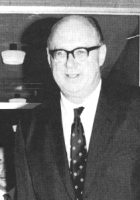 Sir John Cowperthwaite was the main figure responsible for Hong Kong’s economic transformation, lifting millions of people out of poverty. While scholars like Milton Friedman and F. A. Hayek put an intellectual case for the free markets, it was Cowperthwaite who provided the textbook example showing economically liberal policies leading to swift economic development. His practical example provided confidence to the Thatcher and Reagan governments, and was a key influence in China’s post-Mao economic liberalisation.
Sir John Cowperthwaite was the main figure responsible for Hong Kong’s economic transformation, lifting millions of people out of poverty. While scholars like Milton Friedman and F. A. Hayek put an intellectual case for the free markets, it was Cowperthwaite who provided the textbook example showing economically liberal policies leading to swift economic development. His practical example provided confidence to the Thatcher and Reagan governments, and was a key influence in China’s post-Mao economic liberalisation.
Cowperthwaite read classics at St Andrews and Christ’s College, Cambridge. While waiting to be called up by the Cameronians (Scottish Rifles), he went back to St Andrews to study economics. This Scottish education imbibed him with the ideas of the Enlightenment, especially the work of Adam Smith, who had been born nearby in Kirkcaldy. He was a liberal in the 19th century sense, believing that countries should open up to trade unilaterally. In 1941, he joined the Colonial Administrative Service in Hong Kong. When it fell to the Japanese, he was seconded to Sierra Leone as a district officer, before returning in 1946 to help the colony’s economic recovery. “Upon arrival,” the Far Eastern Economic Review put it, “he found it recovering quite nicely without him.” He quickly worked his way up the ranks and was made Financial Secretary in 1961, in charge of its economic policy for a decade.
When he became Financial Secretary, the average Hong Kong resident earned about a quarter of someone living in Britain. By the early 90s, average incomes were higher than Britain’s. Cowperthwaite made Hong Kong the most economically free economy in the world and pursued free trade, refusing to make its citizens buy expensive locally-produced goods if they could import cheaper products from elsewhere. Income tax was never more than a flat rate of fifteen percent. The colony’s lack of natural resources, apart from a harbour, and the fact that it was a food importer, made its success all the more interesting. Cowperthwaite’s policies soon soon attracted the attention of economists like Milton Friedman, whose television series Free to Choose featured Hong Kong’s economic progress in some detail.
Asked what is the key thing poor countries should do, Cowperthwaite once remarked: “They should abolish the Office of National Statistics”. In Hong Kong, he refused to collect all but the most superficial statistics, believing that statistics were dangerous: they would led the state to to fiddle about remedying perceived ills, simultaneously hindering the ability of the market economy to work. This caused consternation in Whitehall: a delegation of civil servants were sent to Hong Kong to find out why employment statistics were not being collected; Cowperthwaite literally sent them home on the next plane back.
Cowperthwaite’s frugality with taxpayers’ money extended to himself. He was offered funds from the Hong Kong Executive to do a much needed upgrade to his official residence, but refused pointing out that since others in Hong Kong did not receive that sort of benefit, he did not see why he should.
Cowperthwaite’s hands off approach, and rejection of the in vogue economic theory, meant he was in daily battle against Whitehall and Westminster. The British government insisted on higher income tax in Singapore; when they told Hong Kong to do the same, Cowperthwaite refused. He was an opponent of giving special benefits to business: when a group of businessmen asked him to provide funds for tunnel across Hong Kong harbour, he argued that if it made economic sense, the private sector would come in and pay for it. It was built privately. His economic instincts were revealed in his first speech as Financial Secretary: “In the long run, the aggregate of decisions of individual businessmen, exercising individual judgment in a free economy, even if often mistaken, is less likely to do harm than the centralised decisions of a government, and certainly the harm is likely to be counteracted faster.”
His ability to pursue policies which, at the time, were deeply unfashionable, was helped by having supportive Hong Kong Governors, Sir Robert Black and Sir David Trench, who both had free market sympathies. Moreover, Cowperthwaite was formidable at arguing his case: as Dennis Healey recalled: “I always retired hurt from my encounters with the redoubtable Financial Secretary.”
From 1972 to 1981, Cowperthwaite was an advisor to Jardine Flemming & Co in Hong Kong. He retired to St Andrews with his wife Sheila and was an active member of the Royal & Ancient. For many years, he spent six months of the year with his wife traveling the world visiting friends and relatives. He was an old school civil servant and, much to the frustration of economists, resisted requests to write an autobiography about his time in Hong Kong, believing that his duty was to serve, not to reveal the minutiae of government business.
– John James Cowperthwaite KBE OBE CMG, Financial Secretary of Hong Kong, born 25 April 1915; died 21 January 2006.
New York in the Early Republic
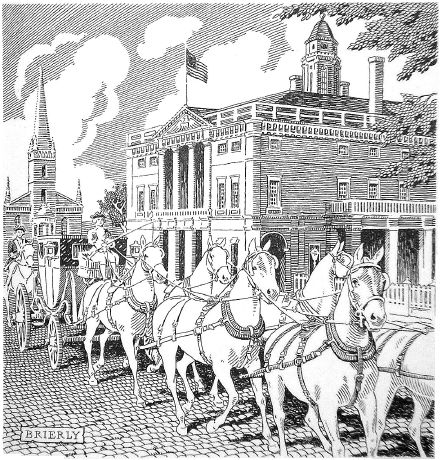
IT IS NOT OFTEN remembered that New York was the first capital of the United States and, as such, was home to the executive, legislative, and judicial branches of the new republic, albeit only for a short time. Federal Hall (above, with the Presidential carriage) was originally constructed in 1699 as a City Hall for New York. It was in this building at 26 Wall Street in 1735 that John Peter Zenger was tried and acquitted of libeling the Governor, affirming the Freedom of the Press. The Continental Congress began meeting in the City Hall in the 1780’s, and with the ratification of the new Constitution of the United States it became the first home of the federal government. Having been elected the first President of the United States, General George Washington was inaugurated on the balcony of the building on April 30, 1789. (more…)
Fresh Kills

Hail, rustic metropolis! I’d file this view of Fresh Kills on Staten Island under ‘You’d Never Believe You’re In New York City‘. The name might seem odd to those who aren’t either New Yorkers or Dutch. ‘Kill’ is a common placename in the Empire State, from the Middle Dutch ‘kille’ meaning riverbank or channel of water. Exempli gratia Arthur Kill, Kill van Kull, Fishkill, and Peekskill in New York, or the Schuykill River in Pennsylvania.
Previously: Rowing in Pelham Bay
How Sensitive the Constabulary are About Their Equine Colleagues!
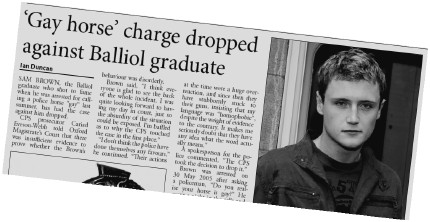
The famous ‘gay horse’ case, in which an Oxford student was being prosecuted for calling a policeman’s horse ‘gay’ at a protest, has been dropped. Even Peter Tatchell, the noxious and himself outrageous head of the outrageous group OutRage!, though the case was outrageous, commenting “The idea that saying a police horse is gay is homophobic is laughable. It brings the police into disrepute.”
‘Gay horse’ case dropped (The Scotsman, Edinburgh)
Case dropped against ‘gay horse’ student (Cherwell, Oxon)
The Queen Mother in New York, 1954
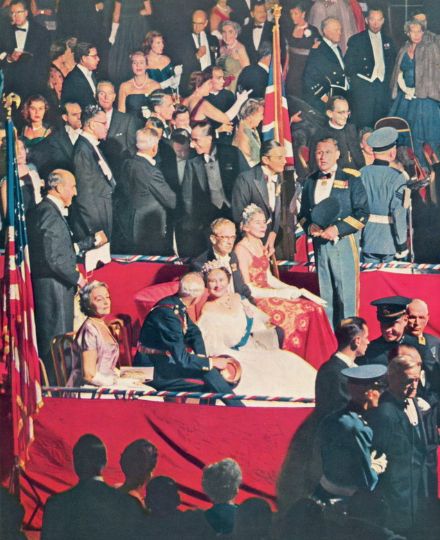
In 1954 Queen Elizabeth, the Queen Mother (n.1900, m.2002) visited New York to accept an educational fund raised by Americans in memory of the late King George VI. On the evening of November 1 of that year, the Seventh Regiment entertained Her Majesty with a special ball held in her honor at the Armory on Park Avenue (view above). Her Majesty also visited the Cathedral of St. John the Divine where she was received by the (Episcopal) Bishop of New York, the Dean, and the clergy of the Cathedral. The three stone blocks on the façade seen in the view below have since been sculpted.
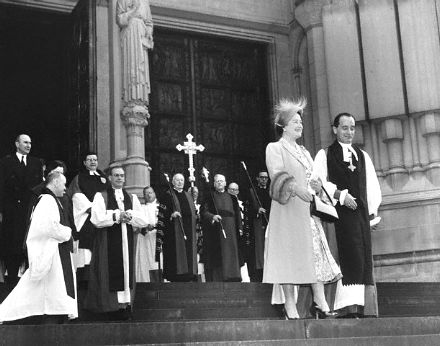
The Last Will and Testament of Louis XVI
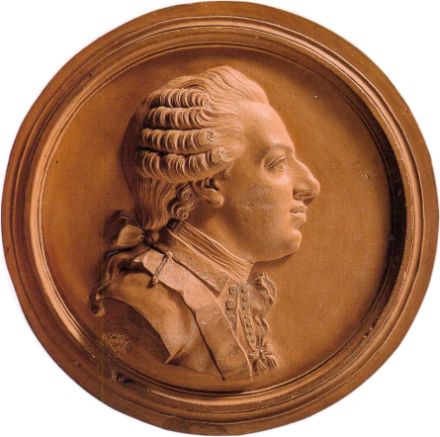
January 21 marked the anniversary of the regicide of Louis XVI, King of France, by the revolutionary authorities.
Here is his last will and testament, written a month previous on Christmas Day.
In the name of the Very holy Trinity, Father, Son and Holy Ghost.
To-day, the 25th day of December, 1792, I, Louis XVI King of France, being for more than four months imprisoned with my family in the tower of the Temple at Paris, by those who were my subjects, and deprived of all communication whatsoever, even with my family, since the eleventh instant; moreover, involved in a trial the end of which it is impossible to foresee, on account of the passions of men, and for which one can find neither pretext nor means in any existing law, and having no other witnesses, for my thoughts than God to whom I can address myself, I hereby declare, in His presence, my last wishes and feelings.
I leave my soul to God, my creator; I pray Him to receive it in His mercy, not to judge it according to its merits but according to those of Our Lord Jesus Christ who has offered Himself as a sacrifice to God His Father for us other men, no matter how hardened, and for me first.
I die in communion with our Holy Mother, the Catholic, Apostolic, Roman Church, which holds authority by an uninterrupted succession, from St. Peter, to whom Jesus Christ entrusted it; I believe firmly and I confess all that is contained in the creed and the commandments of God and the Church, the sacraments and the mysteries, those which the Catholic Church teaches and has always taught. I never pretend to set myself up as a judge of the various way of expounding the dogma which rend the church of Jesus Christ, but I agree and will always agree, if God grant me life the decisions which the ecclesiastical superiors of the Holy Catholic Church give and will always give, in conformity with the disciplines which the Church has followed since Jesus Christ.
I pity with all my heart our brothers who may be in error but I do not claim to judge them, and I do not love them less in Christ, as our Christian charity teaches us, and I pray to God to pardon all my sins. I have sought scrupulously to know them, to detest them and to humiliate myself in His presence. Not being able to obtain the ministration of a Catholic priest, I pray God to receive the confession which I feel in having put my name (although this was against my will) to acts which might be contrary to the discipline and the belief of the Catholic church, to which I have always remained sincerely attached. I pray God to receive my firm resolution, if He grants me life, to have the ministrations of a Catholic priest, as soon as I can, in order to confess my sins and to receive the sacrament of penance.
I beg all those whom I might have offended inadvertently (for I do not recall having knowingly offended any one), or those whom I may have given bad examples or scandals, to pardon the evil which they believe I could have done them.
I beseech those who have the kindness to join their prayers to mine, to obtain pardon from God for my sins.
I pardon with all my heart those who made themselves my enemies, without my have given them any cause, and I pray God to pardon them, as well as those who, through false or misunderstood zeal, did me much harm.
I commend to God my wife and my children, my sister, my aunts, my brothers, and all those who are attached to me by ties of blood or by whatever other means. I pray God particularly to cast eyes of compassion upon my wife, my children, and my sister, who suffered with me for so long a time, to sustain them with His mercy if they shall lose me, and as long as they remain in his mortal world.
I commend my children to my wife; I have never doubted her maternal tenderness for them. I enjoin her above all to make them good Christians and honest individuals; to make them view the grandeurs of this world (if they are condemned to experience them) as very dangerous and transient goods, and turn their attention towards the one solid and enduring glory, eternity. I beseech my sister to kindly continue her tenderness for my children and to take the place of a mother, should they have the misfortune of losing theirs.
I beg my wife to forgive all the pain which she suffered for me, and the sorrows which I may have caused her in the course of our union; and she may feel sure that I hold nothing against her, if she has anything with which to reproach herself.
I most warmly enjoin my children that, after what they owe to God, which should come first, they should remain forever united among themselves, submissive and obedient to their mother, and grateful for all the care and trouble which she has taken with them, as well as in memory of me. I beg them to regard my sister as their second mother.
I exhort my son, should he have the misfortune of becoming king, to remember he owes himself wholly to the happiness of his fellow citizens; that he should forget all hates and all grudges, particularly those connected with the misfortunes and sorrows which I am experiencing; that he can make the people happy only by ruling according to laws: but at the same time to remember that a king cannot make himself respected and do the good that is in his heart unless he has the necessary authority, and that otherwise, being tangled up in his activities and not inspiring respect, he is more harmful than useful.
I exhort my son to care for all the persons who are attached to me, as much as his circumstances will allow, to remember that it is a sacred debt which I have contracted towards the children and relatives of those who have perished for me and also those who are wretched for my sake. I know that there are many persons, among those who were near me, who did not conduct themselves towards me as they should have and who have even shown ingratitude, but I pardon them (often in moments of trouble and turmoil one is not master of oneself), and I beg my son that, if he finds an occasion, he should think only of their misfortunes.
I should have wanted here to show my gratitude to those who have given me a true and disinterested affection; if, on the one hand, I was keenly hurt by the ingratitude and disloyalty of those to whom I have always shown kindness, as well as to their relatives and friends, on the other hand I have had the consolation of seeing the affection and voluntary interest which many persons have shown me. I beg them to receive my thanks.
In the situation in which matters still are, I fear to compromise them if I should speak more explicitly, but I especially enjoin my son to seek occasion to recognize them.
I should, nevertheless, consider it a calumny on the nation if I did not openly recommend to my son MM. De Chamilly and Hue, whose genuine attachment for me led them to imprison themselves with me in this sad abode. I also recommend Clery, for whose attentiveness I have nothing but praise ever since he has been with me. Since it is he who has remained with me until the end, I beg the gentlemen of the commune to hand over to him my clothes, my books, my watch, my purse, and all other small effects which have been deposited with the council of the commune.
I pardon again very readily those who guard me, the ill treatment and the vexations which they thought it necessary to impose upon me. I found a few sensitive and compassionate souls among them – may they in their hearts enjoy the tranquillity which their way of thinking gives them.
I beg MM. De Malesherbes, Tronchet and De Seze to receive all my thanks and the expressions of my feelings for all the cares and troubles they took for me.
I finish by declaring before God, and ready to appear before Him, that I do not reproach myself with any of the crimes with which I am charged.
Made in duplicate in the Tower of the Temple, the 25th of December 1792.
LOUIS
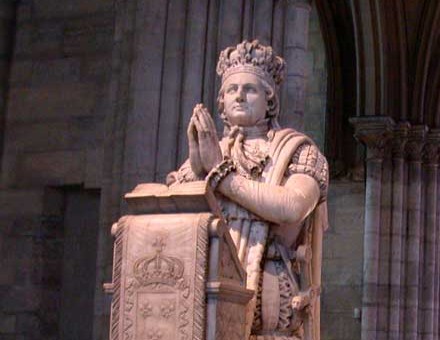
Savoy in New York
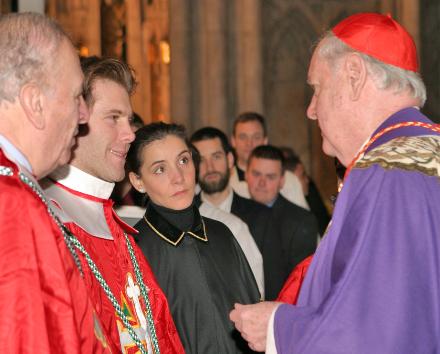
New York recently played host to the Prince and Princess of Venice and Piedmont, Emanuele Filiberto and Clotilde of the House of Savoy. Emanuele Filiberto is the son and heir-apparent of HRH Vittorio Emanuele the Prince of Naples (Vittorio Emanuele IV) who currently lives in voluntary exile from the Italian Republic. The laws forbidding the House of Savoy from visiting and living in Italy were finally overturned in 2002.
The two day visit to New York organized by the American Delagation of Savoy Orders culminated in a Solemn Mass in St. Patrick’s Cathedral on January 6 said by His Eminence Cardinal Egan, himself a Cavaliere di Gran Croce. About three dozen members of the orders of the House of Savoy attended the Mass with friends and family.
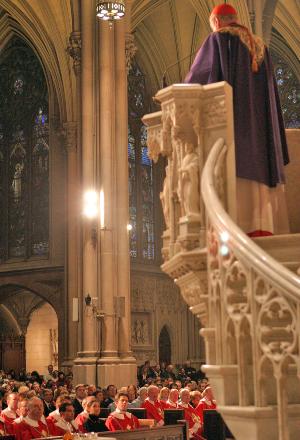
The 7th Regiment in Washington Square
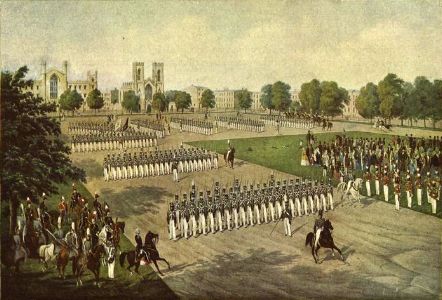
Entitled “National Guard – 7th Regiment New York State Militia”, this mid-nineteenth century view shows the famous 7th Regiment of New York, nicknamed the Silk-Stocking Regiment, parading in Washington Square. In the background can be seen the University of the City of New York and the Church of St. Thomas, which has since moved to Fifth Avenue in Midtown.
Thomas Dongan, 2nd Earl of Limerick
AS VIRGINIA, a year short of four centuries since her foundation, has only recently inaugurated her first Catholic governor, it might be an appropriate time to remember the first Catholic governor of New York, Thomas Dongan (right). Dongan’s tenure as Governor of the Province of New York was one of the most important in the history of our land, and witnessed the formative period of responsible government in what would eventually become the Empire State.
Thomas was born in 1634, the youngest son of Sir James Dongan, Bt., a Member of the Irish Parliament. After the regicide of Good King Charles in 1649, the Catholic family feared persecution and fled to France, as did the Royal Family. In France, having Gallicized his surname to D’Unguent, Thomas joined an Irish regiment and fought under the Vicomte de Turenne (who himself, born into Calvinism, became a Catholic in October 1668). Despite the Restoration of the Crown in Britain and Ireland, Dongan remained in France, being promoted to colonel in his fortieth year. The 1678 Treaty of Nijmegen, however, required all of Charles II’s subjects in the service of France to return home, and so Thomas obliged. Through the efforts of James, Duke of York, with whom Dongan had the privilege of serving in the French Army, he was granted a pension, a high-ranking commission, and was appointed Lieutenant-Governor of Tangiers, of all places, which (along with Bombay) had been given to England as part of the dowry of Catherine of Braganza.
It was in 1682 that James, Duke of York, as Lord Proprietor of New York, appointed Thomas Dongan to govern the bankrupt colony. “In this office,” the Catholic Encyclopedia says, “Dongan proved himself an able lawgiver, and left an indelible mark on political and constitutional history.” He convened the first representative assembly of the Province in 1683, which enacted the Charter of Liberties enunciating the form of government in New York. The Duke of York’s supreme legislative power as Lord Proprietor would reside in a governor, council, and general assembly. Members of the assembly were conferred rights and privileges making their august legislature coequal to and independent of Parliament. Courts of justice were established, liberty of conscience regarding religion was declared, and the principle of no taxation without representation was affirmed. Dongan signed the Charter of Liberties on 30 October 1683, and solemnly proclaimed it the next day at the Stadt Huys, New York’s city hall.
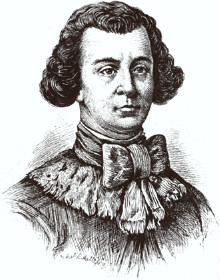 “Thus to Dongan’s term as governor,” quoth the Encyclopedia, “can be dated the Magna Charta of American constitutional liberties, for his system of government became the programme of continuous political agitation by the colonists of New York Province during the eighteenth century. It developed naturally into the present state government, and many of its principles passed into the framework of the Federal Government. Moreover, a rare tribute to his genius, the government imposed by him on New York Province, 1683, was adopted by England after the American War of Independence as the framework of her colonial policy, and constitutes the present [1909] form of government in Canada, Australia, and the Transvaal.”
“Thus to Dongan’s term as governor,” quoth the Encyclopedia, “can be dated the Magna Charta of American constitutional liberties, for his system of government became the programme of continuous political agitation by the colonists of New York Province during the eighteenth century. It developed naturally into the present state government, and many of its principles passed into the framework of the Federal Government. Moreover, a rare tribute to his genius, the government imposed by him on New York Province, 1683, was adopted by England after the American War of Independence as the framework of her colonial policy, and constitutes the present [1909] form of government in Canada, Australia, and the Transvaal.”
The peace and harmony of the Province was furthered in 1684 when Dongan, in the presence of Lord Howard, the Governor of Virginia, received the voluntary submission of the Iroquois confederacy to “the Great Sachem Charles”. The following year saw the death of Charles II and the ascent of the Lord Proprietor, James, Duke of York, to the thrones of England, Scotland, and Ireland. In that year of 1685, Dongan established a Post Office to strengthen communications within his colony and between all the English colonies in America. In the next year, 1686, the Governor granted civic charters to New York and Albany. Dongan’s charter for the City of New York lasted 135 years, while that of Albany was only replaced in 1870. Avid historians would have been bemused/irritated by Archdiocese’s celebration just a few years ago of the two-hundredth anniversary of Catholic education in New York. This would be because New York’s first Catholic school was not in the 1800’s during the republic’s early years but in the 1680’s when Governor Dongan established a college (in the secondary sense) under the guidance of three Jesuit priests, one of whom was his own private chaplain.
Despite the brief attempt to merge New York and New England, followed by the overthrow of James, our last Catholic king, in the so-called ‘Glorious Revolution’, Governor Dongan’s legacy in establishing the institutions of responsible government in New York remains. Indeed he was unquestionably New York’s greatest governor until the advent of ‘Magnus Apollo’ himself, DeWitt Clinton, in the nineteenth century. With the new Protestant Williamite administration in charge, Thomas Dongan returned to England in 1691 and, with the death of his elder brother, inherited the Earldom of Limerick under its first (1686) creation. He died in 1715, poor and childless. Nonetheless, as the Encyclopedia notes:
The tribute of history to his personal charm, his integrity, and character, is outspoken and universal. His public papers give evidence of a keen mind and a sense of humour. He was a man of courage, tact, and capacity, an able diplomat, and a statesman of prudence and remarkable foresight. In spite of the brief term of five years as Governor of New York Province, by virtue of the magnitude, of the enduring and far-reaching character of his achievements, he stands forth as one of the greatest constructive statesmen ever sent out by England for the government of any of her American colonial possessions.
The English Tower and Kavanagh Building
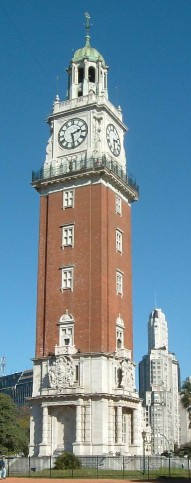 THE SAYING GOES that Argentines are all Italians who speak Spanish and want to be English, which is only just short of the truth. Whatever the quip’s verity, Argentina is a nation of the expatriated and for the centennial year of the 1810 May Revolution, the communities from each of the major mother countries — Spain, Italy, Germany, et cetera — built monuments in dedicated places both to commemorate the contributions their kinsman made to their adopted country as well as to celebrate peace and friendship between Argentina and the given motherland. The Plaza Italia, for example, lamentably bears a monument to the scoundrel Garibaldi, donated by the Italian community.
THE SAYING GOES that Argentines are all Italians who speak Spanish and want to be English, which is only just short of the truth. Whatever the quip’s verity, Argentina is a nation of the expatriated and for the centennial year of the 1810 May Revolution, the communities from each of the major mother countries — Spain, Italy, Germany, et cetera — built monuments in dedicated places both to commemorate the contributions their kinsman made to their adopted country as well as to celebrate peace and friendship between Argentina and the given motherland. The Plaza Italia, for example, lamentably bears a monument to the scoundrel Garibaldi, donated by the Italian community.
For their monumental contribution to the city of Buenos Aires, the English built a tower in the Edwardian style, rather cleverly as it was still the Edwardian period, and the depth of their cleverness was furthered by their naming it the English Tower (officially Torre de los Ingleses, or Tower of the English). Situated in the center of the Plaza Britannia (Britannia Square) at the junction of the San Martin and Libertador avenues, the Tower was designed by engineer Ambrose Poynter and built by Hopkins and Gardom completely (except for mortar) out of materials from England. Around the base are sculptural representations of the English rose, the Scottish thistle, the Welsh dragon, and the Irish shamrock. The dedication at the entrance to the Tower reads “Al Gran Pueblo Argentino. Los residentes británicos. Salud. 25 de mayo 1810-1910” or: “To the Great Argentine People, from the British residents: Salud. May 25, 1810-1910″. Towards the rear of the photo to the right you can see the Kavanagh building (Edificio Kavanagh).
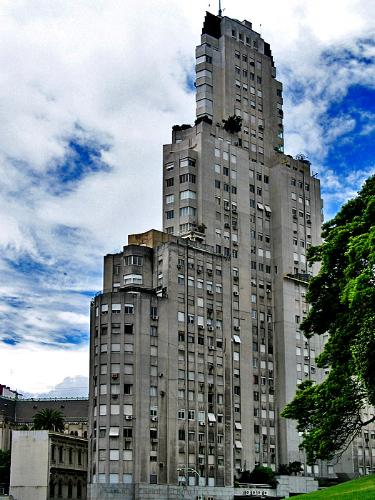
The Kavanagh building is situated on the Plaza San Martin across the avenue from the Plaza Britannia. This 29-storey apartment building was designed by the firm of Sanchez, Lagos, and de la Torre, and was the tallest building in Latin America when built in 1936. The sharp art deco design on an angulated plot is said to resemble a ship at sea, and of course Buenos Aires is a port city — its residents are called porteños after all.
The Kavanagh is unquestionably my favorite ‘modern’ building in Buenos Aires, but then modern architecture has not been kind to the city, at least not in the post-war period (c.f. the National Library). The structures built in the 1950’s were only drab and dull whereas the 60’s and 70’s bore the ill fruits of the ‘lets see how many things we can do with concrete’ trend and tended towards the insidiously hideous rather than the mundane. But no matter however irritating these later obtrusions are, at least Buenos Aires still has the Kavanagh.
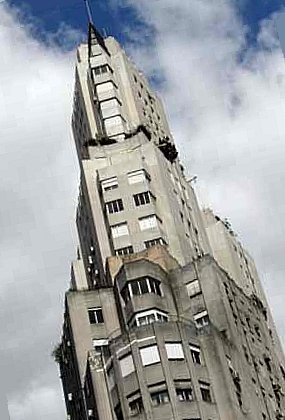
Despite the generations of immigration, investment, interbreeding, and cultural interchange, relations between Argentina and Great Britain were somewhat marred, shall we say, by the shameful attempt by the unhinged wing of the Argentine military to annex the Falklands and rename every geographical feature therein (seriously, I’ve seen the maps). When they were done renaming everything in the Falklands (or ‘Malvinas’ as they would have us believe) the craze apparently spread homewards to the capital. The Plaza Britannia was renamed the Plaza Fuerza Aerea Argentina (from Britannia Square to Argentine Air Force Square), while the Torre de los Ingleses was rechristneed the more ambiguous Torre Monumental. In an even more unfriendly move, the Memorial to the Fallen of the ‘Malvinas’ was built in Plaza San Martin facing the English Tower across the street. In the spirit of peace and friendship, especially regarding two countries which have such deep links as Britain and Argentina, the Memorial really ought to be removed and placed in some other suitable location in the city. Until that time, it remains the Plaza Britannia in my books, and as for the ‘Malvinas’, no such place exists.
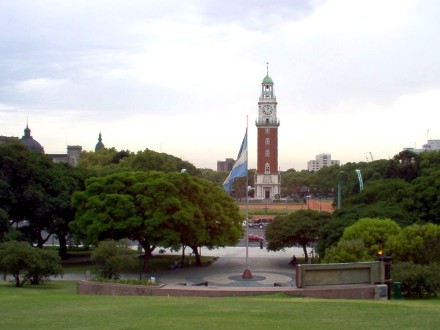
The ‘Malvinas’ memorial viewed from the rear, with the English Tower across the Avenue.
The New PMC
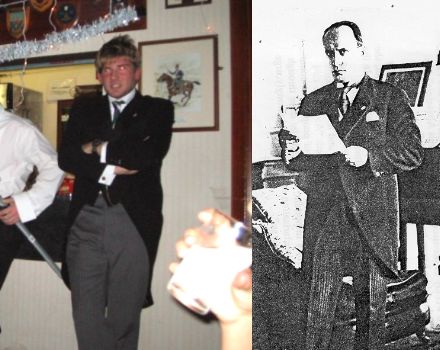
At left: The newly-elected PMC, A Sqn TUOTC, Scotland, 2005. At right: The newly-elected Prime Minister, Italy, 1922. An intriguing juxtaposition.
Though I am still Stateside, I should like extend our slightly belated congratulations to J.E.B., Esq., whom Tom Marshall has described as “the greatest potential cavalryman since Harry Flashman”, on his election to the Presidency of the Mess Committee this past December. Mr. J.E.B. is something of a legend in the Auld Grey Toon and the Mess will benefit from his profound wisdom, not to mention his lack of affection for bad music. A pipe smoker, J.E.B. is the donor of the Mess’s engraved pipe rack which rests on the mantel below the portrait of Her Majesty.
(Photos courtesy of Miss K. Dilworth)
Soggy Manhattan
Ah, Manahatta. Even on a day as soggy as this, the Upper East Side still charms me. It also retains a fair number of buildings from the days when New York had higher tastes, mostly to be found between Fifth and Park Avenues. It is a fact to be mourned that we have probably destroyed most of what was good in New York’s built environment. Nonetheless, we should of course be glad for the beautiful things which remain from our great city’s golden age, and thankfully they are not a mere handful.
Stumbling down East 82nd Street this afternoon amongst puddle, gloom, and rain I emerged onto Fifth Avenue to see the beautiful mass of the Metropolitan Museum of Art revealed in all its glory. The façade of the Met has recently been cleaned and glancing at it today, despite the cloud and percipitation, one could almost imagine the year as 1902 when the wing designed by Richard Morris Hunt was completed. This is doubly so because the Metropolitan currently lacks her usual ungainly vexillic adornments pronouncing the exhibits shown in her distinguished galleries. These banners add nothing to the Met’s façade, and if there is a more clever and handsome way of announcing what is within without – and surely there must be – the Museum does not seem to have found it.
Still, the situation is not as reprehensible as across Central Park at the American Museum of Natural History. The AMNH enjoys two façades, one of which commands the view over Central Park West and the park itself beyond. The main portion of the Museum’s Central Park West front is a brilliant triumphal arch which is in fact the State of New York’s monument and memorial to Theodore Roosevelt, President of the United States and Governor of New York during his earthly life. Shamefully, the Museum disrespects this great monument to this great man by covering it in advertising banners akin to those which usually mar the Metropolitan. The American Museum of Natural History should be ashamed of itself for sullying such an august and dignified locale for the purposes of selfish marketing.
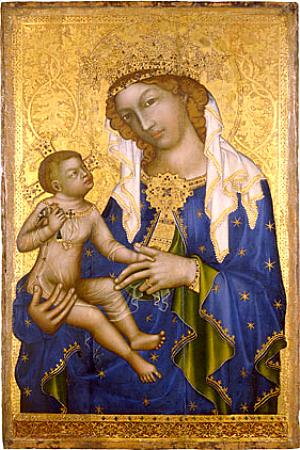
Tempera and gold on panel; 35′ x 23′
Deacon’s Office, Zbraslav/Koenigsaal/Aula Regia
(on loan to the National Gallery, Prague)
What brought me to plod up the splendid elevating staircase of the Metropolitan was to catch – just barely, for this was its last day – the special exhibition entitled Prague: The Crown of Bohemia 1347-1437. I had first gotten wind of this showing flipping through the mail whilst I was still interning at the New Criterion at the end of the summer and duly noted in my diary that though it opened while I was away in Scotland it would still be open upon my return for the Christmas holiday. Anyhow, I finally took advantage of it today and it was much enjoyed. What a remarkable land is Bohemia. The exhibit served only to augment my interest in the country and I must be sure to spend some time there sooner or later.
In addition to the Mother and Child above, the exhibit presented the tabernacle shown below (photographed in its actual home). There were also many, many reliquaries, some of which appeared to still have relics in them. One would have thought a museum’s interest in a reliquary was purely artistic and thus that the relics involved would be removed and handed over to those who would give them the care they deserve. Does the Museum have a consultant to advise on these cases, I wonder? Anyhow, I was sure to touch the glass and ask the saints to pray for us, just in case. The Bohemians clearly knew how to treat relics, would only that New Yorkers did – though to be fair I am told that the Tour of the Relics of St. Thérèse of Liseux which made its way to New York just a few years ago was well attended in the Metropolis and even up in Westchester round my neck of the woods. There is a relic of our dear Thérèse available for veneration in St. Patrick’s Cathedral which I occasionally drop in on when in the neighborhood.
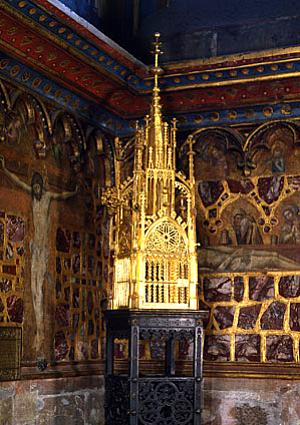
At any rate, had I attended Prague: The Crown of Bohemia 1347-1437 earlier I would’ve enjoined the reader to pay it a visit, but since it has finished its run I instead enjoin our dear readers to at least saunter down Fifth and stop to savor a glance of the cleaned-up Metropolitan sans banners. No doubt it will not be free of them for long — unless they who direct the Museum have had a moment of grace.
Previously: The Remarkable Hapsburgs | Brünn
Search
Instagram: @andcusack
Click here for my Instagram photos.Most Recent Posts
- Amsterdam November 26, 2024
- Silver Jubilee November 21, 2024
- Articles of Note: 11 November 2024 November 11, 2024
- Why do you read? November 5, 2024
- India November 4, 2024
Most Recent Comments
Book Wishlist
Monthly Archives
Categories

